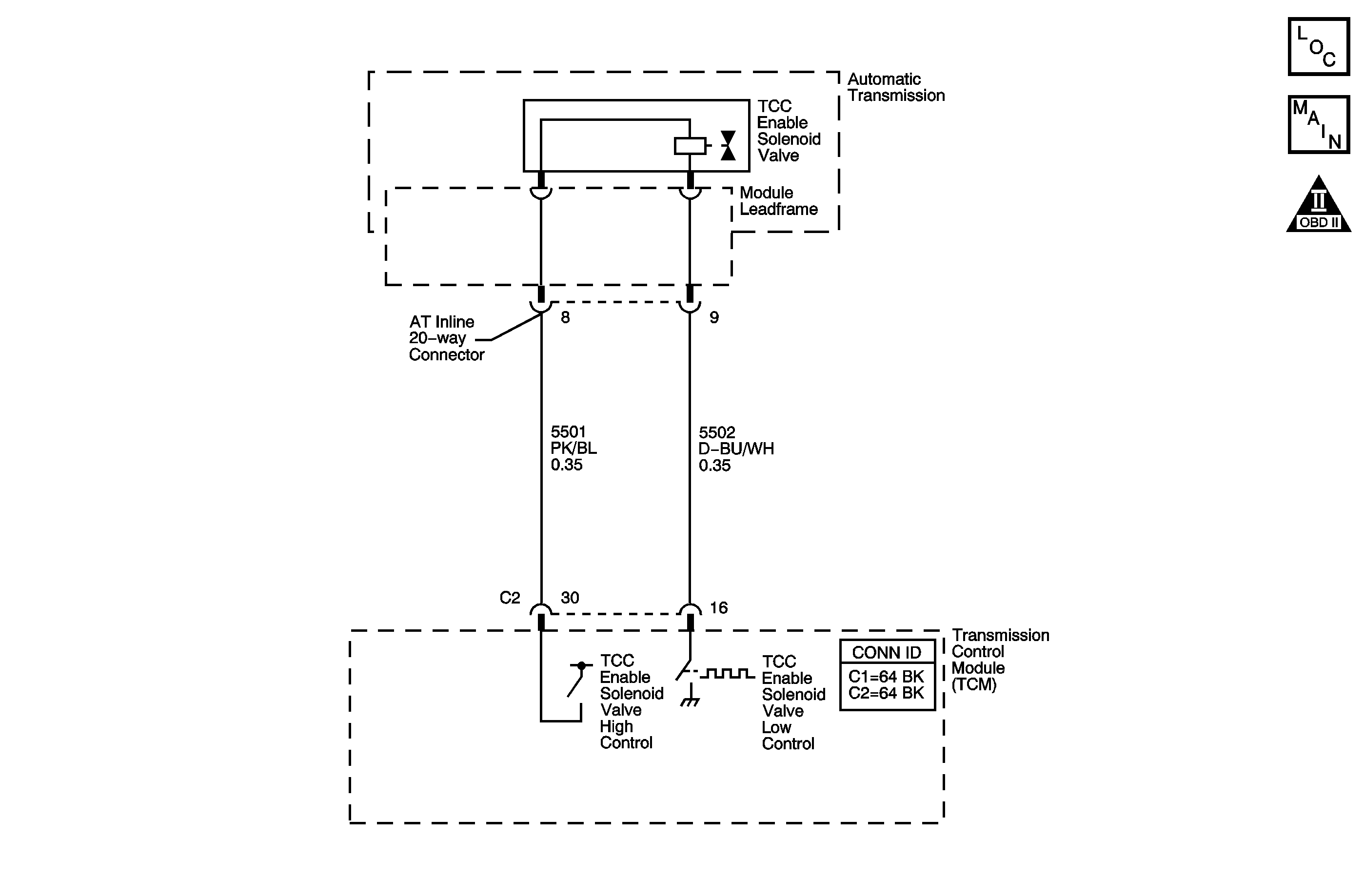
Circuit Description
The transmission control module (TCM) uses the torque converter clutch (TCC) enable solenoid valve to hydraulically select whether the TCC pressure control solenoid valve will control the fluid pressure to apply the forward and reverse clutches or the fluid pressure to apply the torque converter clutch. The TCC enable solenoid valve is attached to the control valve assembly. The TCM compares engine and transmission inputs to determine if the solenoid should be enabled. The TCM then enables the solenoid by providing a ground. The TCM monitors the status of the low control circuit and can detect a short to power or a short to ground/open.
When the TCM detects a short to voltage, DTC P1889 sets. DTC P1889 is a type A DTC.
Conditions for Running the DTC
| • | The engine speed is greater than 500 RPM for 5 seconds. |
| • | The TCC enable solenoid valve high side driver is enabled. |
| • | The TCC enable solenoid valve is enabled |
Conditions for Setting the DTC
The TCM detects a short to voltage for 0.1 seconds.
Action Taken When the DTC Sets
| • | The TCM requests the ECM to illuminate the malfunction indicator lamp (MIL). |
| • | The TCM limits the commanded speed ratio to 1.6 or less. |
| • | The TCM inhibits TCC engagement. |
| • | The TCM turns the power off to the TCC enable solenoid valve. This results in no TCC engagement. |
| • | The TCM freezes torque converter clutch (TCC) transmission adaptive functions. |
| • | The ECM records the operating conditions when the Conditions for Setting the DTC are met. The ECM stores this information as Freeze Frame and Failure Records. |
| • | The TCM records the operating conditions when the Conditions for Setting the DTC are met. The TCM stores this information as Failure Records. |
| • | The TCM stores DTC P1889 in TCM history. |
Conditions for Clearing the MIL/DTC
| • | The ECM turns OFF the MIL after the third consecutive drive trip in which the TCM does not send a MIL illumination request. |
| • | A scan tool can clear the MIL/DTC. |
| • | The TCM clears the DTC from TCM history if the vehicle completes 40 warm-up cycles without an emission related diagnostic fault occurring. |
| • | The TCM cancels the DTC default actions when the ignition switch is OFF long enough in order to power down the TCM. |
Diagnostic Aids
| • | Inspect the connectors at the TCM, the transmission, and all other circuit connecting points for an intermittent condition. Refer to Testing for Intermittent Conditions and Poor Connections in Wiring Systems. |
| • | Inspect the circuit wiring for an intermittent condition. Refer to Testing for Electrical Intermittents in Wiring Systems. |
Step | Action | Values | Yes | No | ||||
|---|---|---|---|---|---|---|---|---|
1 | Did you perform the Diagnostic System Check - Engine Controls? | -- | Go to Step 2 | Go to Diagnostic System Check - Engine Controls in Engine Controls - 2.2L (L61) | ||||
2 |
Important:
Does the DTC fail this ignition? | -- | Go to Step 3 | Go to Intermittent Conditions in Engine Controls - 2.2L (L61) | ||||
3 |
Does the test lamp illuminate? | -- | Go to Step 4 | Go to Step 5 | ||||
4 | Test the low control circuit of the TCC enable solenoid valve for a short to voltage. Refer to Testing for a Short to Voltage and Wiring Repairs in Wiring Systems. Did you find and correct the condition? | -- | Go to Step 7 | Go to Step 6 | ||||
5 | Replace the TCC enable solenoid valve. The TCC enable solenoid valve is part of the control solenoid valve assembly. Refer to Control Valve Body Assembly Disassemble . Did you complete the replacement? | -- | Go to Step 7 | -- | ||||
6 | Replace the TCM. Refer to Transmission Control Module Replacement . Did you complete the replacement? | -- | Go to Step 7 | -- | ||||
7 | Perform the following procedure in order to verify the repair:
Has the test run and passed? | -- | Go to Step 8 | Go to Step 2 | ||||
8 | With the scan tool, observe the stored information, capture info and DTC info. Does the scan tool display any DTC's that you have not diagnosed? | -- | Go to Diagnostic Trouble Code (DTC) List in Engine Controls - 2.2L (L61) | System OK |
